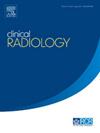A nomogram for predicting heterogeneous etiology of atherosclerosis in the left anterior descending coronary artery using geometric morphological parameters
IF 2.1
3区 医学
Q2 RADIOLOGY, NUCLEAR MEDICINE & MEDICAL IMAGING
引用次数: 0
Abstract
AIM
This study aims to analyse the correlation between the geometric morphology of the left anterior descending (LAD) artery and the severity of arterial stenosis in order to explore potential causes of atherosclerotic heterogeneity.
MATERIALS AND METHODS
Geometric morphological parameters, including curvature, torsion, and tortuosity index (TI), along with anatomical features of surrounding accessory structures, were derived from coronary computed tomography angiography (CCTA). By integrating clinical indicators and serological results, a logistic regression model was developed to predict moderate to severe stenosis of the LAD (MSS-LAD). A novel nomogram was constructed based on significant influencing factors identified in the model, and its predictive performance was validated.
RESULTS
In this single-centre retrospective study, out of 115 CCTA cases in the training set, 49 were identified with MSS-LAD. Significant differences were observed in the classification of ramus intermedius-diagonal branch (RI-D), fat volume (FV), average torsion (AT), and AT of the proximal and mid (AT-PM) between groups (p<0.05). Multivariate logistic regression analysis indicated that body mass index (BMI), RI-D classification, FV, and AT-PM were significant predictors of MSS-LAD (p<0.05). A nomogram for predicting MSS-LAD was constructed based on these four indicators, demonstrating good predictive performance in both the training set (area under the curve [AUC]: 0.839; 95% confidence interval [CI]: 0.762–0.961) and the validation set (AUC: 0.790; 95% CI: 0.665–0.915).
CONCLUSION
There is a complex interaction between the geometric configuration of coronary arteries and atherosclerotic plaque formation. The risk nomogram established by combining anatomical features of surrounding accessory structures and clinical indicators effectively predicts MSS-LAD. It may be considered for inclusion in future risk assessment and management protocols for populations at high risk of coronary heart disease.
求助全文
约1分钟内获得全文
求助全文
来源期刊

Clinical radiology
医学-核医学
CiteScore
4.70
自引率
3.80%
发文量
528
审稿时长
76 days
期刊介绍:
Clinical Radiology is published by Elsevier on behalf of The Royal College of Radiologists. Clinical Radiology is an International Journal bringing you original research, editorials and review articles on all aspects of diagnostic imaging, including:
• Computed tomography
• Magnetic resonance imaging
• Ultrasonography
• Digital radiology
• Interventional radiology
• Radiography
• Nuclear medicine
Papers on radiological protection, quality assurance, audit in radiology and matters relating to radiological training and education are also included. In addition, each issue contains correspondence, book reviews and notices of forthcoming events.
 求助内容:
求助内容: 应助结果提醒方式:
应助结果提醒方式:


